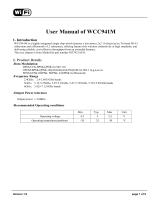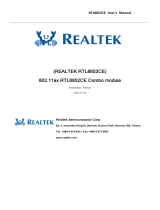Vous trouverez ci-dessous de brèves informations pour Module Wi-Fi et Bluetooth WCC940M. Ce module offre une connectivité sans fil riche en fonctionnalités avec un sous-système Wi-Fi tri-bande 2x2 11a/b/g/n/ac/ax basse consommation et un sous-système Bluetooth v5.2. Il fournit un débit fiable et rentable à partir d'une distance étendue. Il prend en charge diverses modulations de données, plusieurs bandes de fréquences, et fonctionne dans des conditions de température spécifiées. Le module est également livré avec des déclarations d'approbation FCC et des restrictions de logiciels RF.
Vous trouverez ci-dessous de brèves informations pour Module Wi-Fi et Bluetooth WCC940M. Ce module offre une connectivité sans fil riche en fonctionnalités avec un sous-système Wi-Fi tri-bande 2x2 11a/b/g/n/ac/ax basse consommation et un sous-système Bluetooth v5.2. Il fournit un débit fiable et rentable à partir d'une distance étendue. Il prend en charge diverses modulations de données, plusieurs bandes de fréquences, et fonctionne dans des conditions de température spécifiées. Le module est également livré avec des déclarations d'approbation FCC et des restrictions de logiciels RF.









-
 1
1
-
 2
2
-
 3
3
-
 4
4
-
 5
5
-
 6
6
-
 7
7
-
 8
8
-
 9
9
Vous trouverez ci-dessous de brèves informations pour Module Wi-Fi et Bluetooth WCC940M. Ce module offre une connectivité sans fil riche en fonctionnalités avec un sous-système Wi-Fi tri-bande 2x2 11a/b/g/n/ac/ax basse consommation et un sous-système Bluetooth v5.2. Il fournit un débit fiable et rentable à partir d'une distance étendue. Il prend en charge diverses modulations de données, plusieurs bandes de fréquences, et fonctionne dans des conditions de température spécifiées. Le module est également livré avec des déclarations d'approbation FCC et des restrictions de logiciels RF.
dans d''autres langues
- English: Wi-Fi WCC940M User manual
Autres documents
-
 WiFi WCC941M Manuel utilisateur
WiFi WCC941M Manuel utilisateur
-
Mediatek MT7922A22M Mode d'emploi
-
Mediatek MT7922A12L Mode d'emploi
-
Mediatek MT7922A12L Mode d'emploi
-
Mediatek MT7922A22M Mode d'emploi
-
Mediatek MT7922A22M Mode d'emploi
-
 Realtek RTL8852CE Manuel utilisateur
Realtek RTL8852CE Manuel utilisateur
-
Askey AP6275S Manuel utilisateur
-
GSD WXT2F Manuel utilisateur
-
DOODLe labs ACM-DB-2M Mode d'emploi










